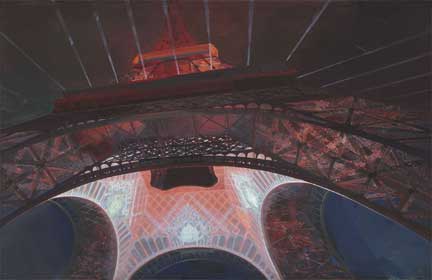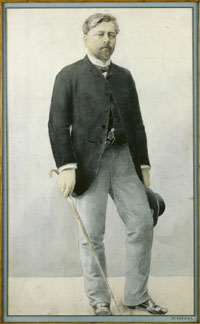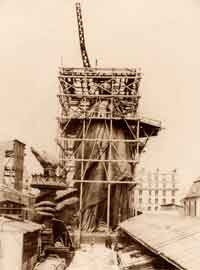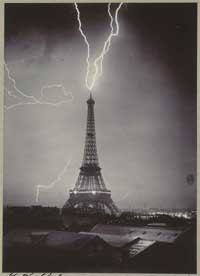Gustave Eiffel: iron magic
by Alison Hird
Article published on the 2009-05-23 Latest update 2009-05-24 08:35 TU
French writer Guy de Maupassant was one of several in the Paris art world to sign the Artists’ Petition against the “useless and monstrous Eiffel Tower”, a blot on the Paris landscape. Iron was a vulgar metal, used only for commercial concerns like shops or railways. Anything dignified and artistic required stone.
One hundred and twenty years later, the iron lady is the most visited paying monument in the world: some seven million people flock to marvel at her iron curves every year. For the French it’s the symbol of Paris; for many foreigners, it evokes the entire country.
But there would be no iron lady without the iron magician that created her. And while Gustave Eiffel is most famous for the tower, the engineer’s savoir faire can be seen in cities all over the world: the Budapest railway station, the road bridge over the oued Djemma in Algeria, the armature of the Statue of Liberty in New York, the railway bridge over the Douro in Portugal - all bear the Eiffel stamp of elegance, strength and thrift.
Caroline Matthieu, curator of the exhibit Gustave Eiffel, le magicien du fer (the magician of iron), and in charge of architecture collections at Paris’ Orsay museum, says she wanted to bring out the elegant and innovative way Eiffel used iron.“I want the public to see he’s not just the man of the tower, but also of bridges… and who did important work in the field of aerodynamics,” she explains.
Eiffel specialised in portable bridges – an activity he developed through his company workshop in Levallois-Perret, north of Paris. Amazing given their size, they could literally be dismantled and exported all over the world in kit form.
“You assembled the whole bridge on the riverbank and threw it onto the river,” says Matthieu. The exhibition shows photos of this remarkable process that was used to the 1940s and proved highly lucrative for Eiffel.
In France he designed the Bordeaux bridge - at 500 metres, the longest in Europe at the time - and the Garabit viaduct. But it was the Douro viaduct in Portugal, built in 1877, that brought Eiffel international renown. A savvy businessman, he won the tender for the bridge using an innovative technique that required next to no scaffolding, which was developed by the English, but Eiffel undercut their bid by half, largely through economising on staff.
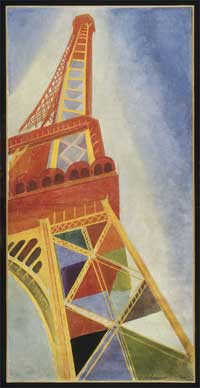
La Tour Eiffel, Robert Delaunay, 1926
(c) L & M services B.V. The Hague 20090103 / (c) Photo CNAC/MNAM
Eiffel made a fortune with his project to build locks on the Panama
Canal in the early 1890s. But he was also accused of corruption, and he lost his légion d’honneur. While he was later vindicated, he retired from the Eiffel Company and turned to research into aeronautics.
He worked with aviators Bréguet and Blériot and designed a fighter plane in 1917. His aerodynamics laboratory in Paris’s 16th arrondissement is still in operation and specialises in construction research.
Despite Eiffel’s varied career, it’s his tower that eclipses everything else.
The Gustave Eiffel, le magicien du fer exhibit shows reproductions in metal and alabaster, along with photos of it being assembled, like some big meccano set. with scaffolding up to the first floor and crates of compressed air on the banks of the Seine to steady the ground.
Other photos and working documents show how puddled iron parts containing carbon (more flexible than cast-iron) came partly assembled and were then riveted into place on site.
Documents, photos and letters show how difficult it was to organise the construction of the tallest building in the world (300 metres high) at the time. Even Eiffel himself was reticent over the designs of two of his engineers, Maurice Koechlin and Emile Nougier. It took the more aesthetic approach of architect Stephen Sauvestre to bring him on board.
No one, let alone Eiffel, imagined the tower would become such an international star, “one of the wonders of the world” according to painter Robert Delaunay.
But artists were drawn to the tower, inspired by its elegant structure, modernity and “the way it plays with the wind” says curator Caroline Matthieu.
Raoul Dufy, Henri Riviere and Man Ray are but three to have immortalised the tower in their work.
The exhibition reminds us the iron lady very nearly didn’t make it into the twentieth century at all! She wasn't built to last, and the city of Paris planned to tear her down once Eiffel’s 20-year permit expired. But as a photo of the Eiffel Tower hit by lightning clearly shows, she was, like many a female, a rather good communicator: she transmitted the first radio transmissions in 1898.
Exhibition Gustave Eiffel, le magicien du fer, at Paris’ Hotel de Ville, 75004, until 29 August 29. Admission: Free.
Culture
Cracking skulls!
2010-02-15 12:35 TU
France's gothic avant-garde
2010-02-13 15:16 TU
Winter sounds warm up French jazz fans
A tribute to trumpeter Don Cherry at a Free Jazz showcase festival outside of Paris.
2010-01-31 11:55 TU
Trance on a trapeze
2010-01-30 12:41 TU
Retro Mobile - classic car exhibition
260,500 euros for rusty old car found at bottom of lake
A rusty old Bugatti, which spent years at the bottom of a Swiss lake, sold for 260,500 euros at the Retro Mobile classic car exhibition on Saturday. Other more lovingly-restored pristine examples are exciting enthusiasts from across the world in a special anniversary event at Porte de Versailles in Paris.
2010-01-23 20:21 TU
France's changing face looks east
2010-01-22 16:17 TU
Putting art on film
2010-01-20 13:09 TU
What sex is a coffee bean, where does the aubergine come from?
2010-01-08 16:08 TU
Cocteau Twin flying solo
2010-01-06 16:43 TU
A taste of Nordic filmmaking in Paris
Ciné Nordica 2009 at Paris’s Panthéon cinema showcases filmmaking from Scandinavia. So what makes Nordic film different from the rest?
2009-12-22 17:15 TU




